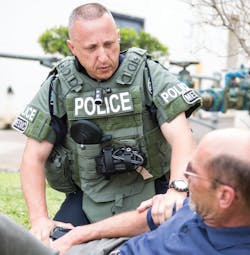This story originally appeared on Officer.com partner site EMSWorld.com
Telemedicine isn’t new, though it has not yet achieved widespread adoption.
One area it could begin gaining traction, however, is in the tactical realm. Tactical telemedicine takes an existing telemedicine framework and puts it in the hands of military personnel or SWAT team medics, who often find themselves on the ground in high-risk settings without immediate medical support.
The military has been exploring real-time, electronic point-of-treatment care for the battlefield, but it’s still largely in the testing phase.
One place the technology will soon be deployed is Palm Bay, FL. There the Palm Bay Police Department and the Trauma Center at Health First/Holmes Regional Medical Center partnered to create the Tactical Telemedicine Program, or Tac-Tel. The partnership also includes firefighter-paramedics who train alongside Palm Bay SWAT officers.
Tac-Tel provides physicians at the trauma center with a direct link to a scene via a smartphone or tablet and a tiny camera affixed to a SWAT medic. The connection is secure, wireless and real-time.
“It gives us the earliest possible view of any potential casualty,” says Peter Pappas, MD, a trauma and acute care surgeon at Holmes Regional Medical Center, who helped develop the technology.
Palm Bay Police Captain John Resh adds, “Right now, at the touch of a button, I’m live audio and video to the trauma doctor.”
That kind of response time allows doctors to begin evaluating a patient as soon as they’re injured, Pappas says.
“When someone is severely injured, actions taken and decisions made within that first hour are crucial to obtaining the best possible outcome for a patient,” says Pappas. “This technology is a way for us to squeeze every second out of that critical golden hour.”
Program leaders say bringing life-saving care closer to the initial time of injury during tactical events is the key.
The Tac-Tel program actually got its start a few years ago, when Pappas and Palm Bay Police Chief Doug Muldoon met to discuss ways to incorporate telemedicine. From there, they worked with Health First and Palm Bay IT analysts to develop the Tac-Tel system equipment and connect it to the Health First tele-presence network. The final step was the active support and involvement of Resh and the Palm Bay SWAT team in training and testing. Testing began in 2011, but following the tragic death of Brevard County Sheriff’s Deputy Barbara Pill—who was shot and killed during a March 2012 traffic stop—the need became even clearer.
A big advantage to the technology, according to Muldoon, is it provides peace of mind for the medics and SWAT personnel who are otherwise engaged in a potentially volatile situation. “You already have on your mind all the other things from a safety perspective—the equipment you have to use, the vehicles, weapons, the whole nine yards,” Muldoon explains. “And then the fact that you’re relying on as much intelligence to make informed decisions on how you deploy the officers, what kind of tactics do you use?”
All of that, and the fact responders are presumably engaging the individual(s) responsible for causing the patient injuries, are why letting the trauma doctors examine the patient remotely and in real time is so important.
Compared to the benefits of the technology, the cost to Palm Bay has been negligible. The City of Palm Bay was allowed access to the Florida Trauma Telemedicine Network (FTTN) without having to purchase special tele-presence equipment that normally costs several hundred thousand dollars. With just a department laptop or tablet, a 4G hotspot and a commercial USB camera and headset, SWAT medics in the field are able to connect with trauma center for less than $1,500.
The Tac-Tel program has only been used on a trial basis so far but the target date for a live launch is this September. Ideally, it’s not technology that will ever have to be used. But its potential applications are broad, including mass casualty incidents, where trauma surgeons could see their patients and begin treating them well before they arrive at the hospital and inundate staff.
The City of Chicago has even reached out to Palm Bay for input on how to develop a similar program to help save lives during a critical incident. Other local governments and agencies are encouraged to connect with Palm Bay’s Tac-Tel leaders to learn more about the program.



